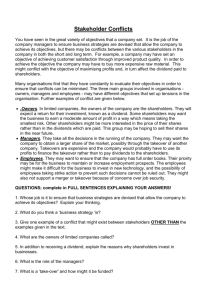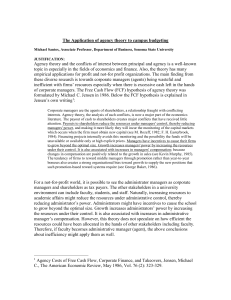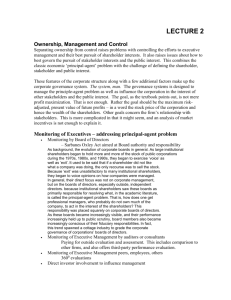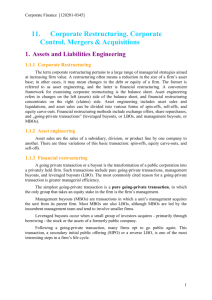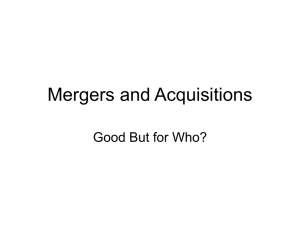AGENCY THEORY
advertisement
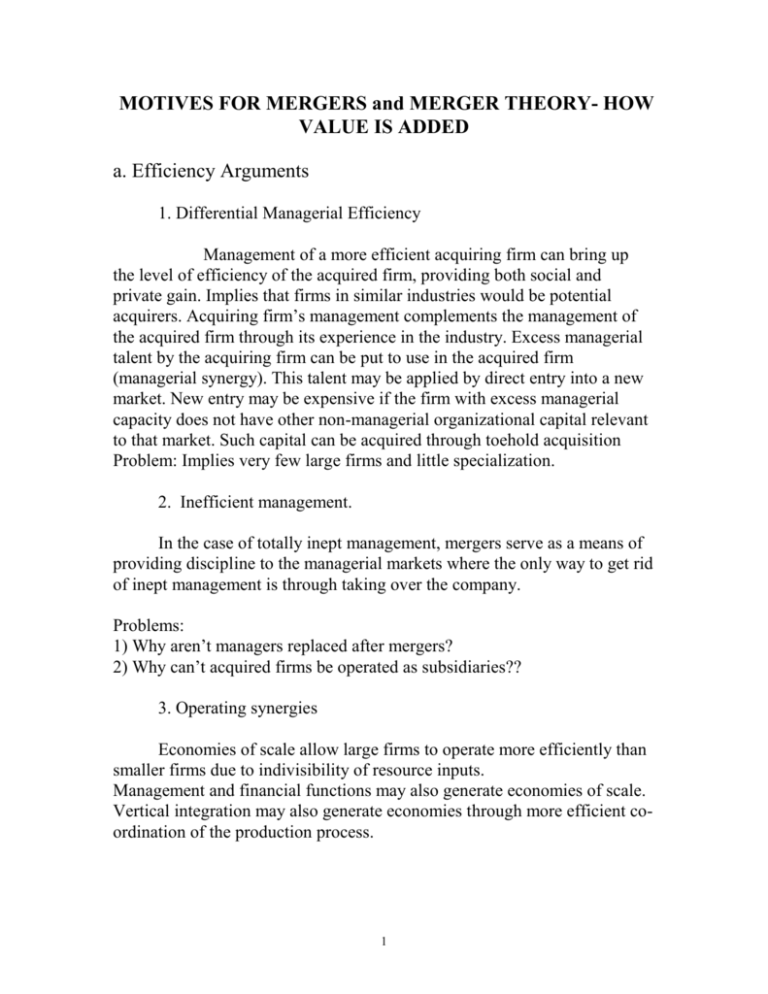
MOTIVES FOR MERGERS and MERGER THEORY- HOW VALUE IS ADDED a. Efficiency Arguments 1. Differential Managerial Efficiency Management of a more efficient acquiring firm can bring up the level of efficiency of the acquired firm, providing both social and private gain. Implies that firms in similar industries would be potential acquirers. Acquiring firm’s management complements the management of the acquired firm through its experience in the industry. Excess managerial talent by the acquiring firm can be put to use in the acquired firm (managerial synergy). This talent may be applied by direct entry into a new market. New entry may be expensive if the firm with excess managerial capacity does not have other non-managerial organizational capital relevant to that market. Such capital can be acquired through toehold acquisition Problem: Implies very few large firms and little specialization. 2. Inefficient management. In the case of totally inept management, mergers serve as a means of providing discipline to the managerial markets where the only way to get rid of inept management is through taking over the company. Problems: 1) Why aren’t managers replaced after mergers? 2) Why can’t acquired firms be operated as subsidiaries?? 3. Operating synergies Economies of scale allow large firms to operate more efficiently than smaller firms due to indivisibility of resource inputs. Management and financial functions may also generate economies of scale. Vertical integration may also generate economies through more efficient coordination of the production process. 1 4. Financial Synergies. Internal funds allow a less costly and more efficient means to finance expansion that reliance on external funds. This would allow cash-rich firms to provide financing for cash-poor companies. It might also allow for economies of scale in the financing of projects. The debt capacity of a combined company may exceed the debt capacity of its components because the variability of cash flow is reduced. 5. Pure diversification. For shareholders, diversification at the shareholder level is equivalent to diversification at the firm level, but should be cheaper, since acquisition costs are much less. For managers, firm diversification is much preferable since human capital is concentrated in a specific firm and depends on the fortunes of that firm. By diversifying, managers gain more job security and perhaps the firm gains lower labor costs. Firm diversification also allows protection of firm-specific information and the firm’s reputation capital against firm liquidation. Debt capacity can be raised by diversification. 6. Strategic realignment Change can be effected more quickly by entry into a new product or market through merger than through direct entry. Where values are ephemeral, it may pay to acquire rather than to build. Problem: The price for timely acquisition may fully reflect value. 7. Undervaluation The market may not fully reflect the true value of a potential acquisition, which may be known by competitors and managers in the industry with access to privileged information. 2 Assets may be acquired more cheaply in the aftermarket than by building. The allows assets to be acquired whenever market values are lees than their replacement cost. Tobin’s q = market value/replacement cost A q value less than one implies negative NPV projects or assets that are worth less than their cost. Problem: bringing up value of assets still requires greater efficiency by the acquirer. 3 b. Agency problems, managerialism, and free cash flow Overview: Agency problems in relationships arise whenever the two parties do not have exactly the same objective function. Then, benefits to one of the parties can come at the expense of another party. In the context of the differences between objectives of management and shareholders, agency problems can lead to inefficiencies, which inefficiencies may be resolve by means of the market’s discipline of managers through takeovers or the threat of takeovers. Examples: Manager/employees vs. stockholder/owners Managerial perks are paid for by shareholders Inefficiency is a form of managerial perk. Stockholders vs. bondholders Application of option pricing theory to stock valuation 1. Mergers as a solution to agency problems If managers have created inefficiencies, then the stock price will not be as high as possible had such inefficiencies not existed. The presence of inefficiencies opens the opportunity for an outsider to buy assets at a discount, resolve the inefficiencies, and bring the assets up to full value. 2. Mergers as an outcome of managerialism Managers may have incentives to maximize the size of assets managed rather than maximizing shareholder wealth if their incomes or economic power is more related to the size of their managerial scope. They are incented to add assets for their own purposes rather than to make shareholders better off. The discipline of a merger would strip inefficient or un-needed assets and reduce the firm to its proper size. 4 3. Conflicts over the distribution of cash flows Managers and shareholders may have different objectives represented in preferences for use of the firm’s internally generated cash, with managers wanting the firm to become larger while shareholders would prefer to obtain cash through dividends or share repurchases. 4. The rationale for the use of debt. Interest and principal payments provide discipline for managers in running a tighter ship to assure that cash is available for fixed financial charges. Financing associated with Leveraged buyouts or management buyouts can impose such discipline. Problem: a merger is not a necessary condition for imposition of debt discipline. It can be implemented independently of mergers. In Phillips Petroleum example, the leveraged re-financing serves a very effective takeover defense, not to make the takeover more costly, but to add value without a takeover. 5. The Free Cash Flow problem. Agency problems are heightened when management has financial flexibility at its disposal in the form of the ability to generate cash from operations or in pools of liquid assets built up. Buildup of free cash flow in a) current assets b) pension fund c) borrowing capability can be used by managers to benefit themselves directly (higher salary) or indirectly (poor investments) at the expense of shareholders. Firms with good investment opportunities have greater need for financial slack (free cash flow) and are less likely to waste free cash. Firms with poor investment opportunities may be inclined to invest anyway simply because ample cash is available. Example: Cash-rich oil companies with poor investment opportunities being the subject of and the subject of takeover battles in the 1980’s. Takeovers prevented oil companies from wasting cash in negative NPV investment because of managerialism. 5 Empirical Evidence on Free Cash Flow problems Investments (McConnell and Muscarella) Regular Dividends (Lang and Litzenberger, Denis, Denis, and Sarin) Special Dividends (Howe, He, and Kao; Gombola and Liu) Stock Repurchases (Porter, Roenfeldt and Sicherman) 6 c. Information and signaling arguments Basic Concept: Information is not shared equally between parties in a transaction. Sellers and job applicants know more about the item offered or skills available than buyers or employers. Managers know more abut the condition of the firm than investors or the managers of an acquiring firm. Pooling Equilibrium When individual characteristics are unknown then group characteristics are assigned rather than individual characteristics. Example: All used cars are classified as “lemons”. Graduates of prestigious universities are considered smarter and harder-working Resolution Costless signaling is worth what it costs. Costly signaling is difficult to signal falsely. Empirical Research : Stock offerings (Asquith and Mullins, Brous) Regular dividend increases and decreases (asymmetry) Stock repurchases (Comment and Jarrell, Jain) Investment Announcements (McConnell and Muscarella, John and Mishra) Divestment Announcements (Blackwell, Marr, and Spivey, Gombola and Tsetsekos). 7 1. Information implications of merger activity. Investors learn information about a company when it goes in play as a takeover target. Its value is revised upward. The revision may be due to a combination of two explanations. \ Explanation #1. - “Sitting on a gold mine” The target shares and assets may be undervalued because of their higher value for an alternative owner who may place assets at a higher and better use. If one outsider can add value, then other potential new owners may also add value. Explanation #2 - "Kick in the pants" When managers learn of the potential for the discipline of a merger, they institute pre-emptive steps to initiate the discipline by themselves. 2. Signaling implications The form of mergers can be used to glean information about bidders and targets. A bidder that uses common stock rather than cash may signal that the bidder’s own stock may be overvalued, or it may signal that the bidder is unsure of the target’ value and wishes target shareholders to share in the risk of potential mis-estimation of the target’s value. 8 d. Market Power considerations 1. Market Share Any merger will increase market share, but market share may not be translated into higher profits and higher share value. Problem: Legal problems associated with “undue concentration” in an industry. Old guidelines implied concentration when the four largest firms accounted for 40 percent or more of sales. Herfindahl index takes into account the relative share of all firms in the industry as H = of industry)2 where N is the number of firms at any percentage of industry sales. 2. Monopoly and monopsony power. 9 e. Wealth Redistribution 1. Shareholders versus bondholders. Mergers are often, but not necessarily, accompanied by opportunities to change capital structure in a manner that disciplines management. Substitution of debt for equity applies such discipline, but also provides shareholders with an opportunity to transfer bondholder wealth to themselves. Losses by bondholders will increase the wealth of shareholders, even with no change in the value of assets. Viewing the equity as an option on underlying firm assets produces the same implications. Sale of assets to generate cash also undercuts the value of bonds since fewer assets reduces the cash flow available for paying interest and principal. Examples: In the KKR takeover of RJR assets sales of $5 billion and sale of junk bonds that produced a net loss after interest of $976 million. In Phillips Petroleum defense against takeover, the leveraged refinancing hurt the value of existing bonds. Equity was reduced from $6.6 billion in 1984 to $1.6 billion in 1985, while long-term debt increased from $2.8 billion in 1984 to $6.5 billion in 1985. (Notice that takeover was averted by management pre-emption of takeover strategies). 2. Shareholders versus other stakeholders. A. Employees In a merger, the acquiring firm and its new management may not feel as responsible for the welfare of employees or other stockholders. The result can be much of the “efficiencies” of mergers. Example: Acquisition of TWA by Icahn produced cost savings of $200 million per year by means of wage reductions forced on employees. 10 It can be argued whether this is the result of a “breach of trust” or an end to regulation. B. Government Greater leverage and reduced tax payments may transfer wealth from society to shareholders. 11 II. The Free Rider Problem Source of the problem: 1. Outside acquirer pays a premium that incorporates much of the benefits of the merger 2. All of risk is borne by acquirer 3. Most of benefits of the merger are enjoyed by inside stockholdersyet they do nothing to add value to the firm. 4. Merger can fail because original shareholders have no incentive to tender Resolving the problem: Transferring merger benefits from acquired-firm shareholders to acquiring firm. 1. Dilutive activity 2. Two-tier offer 12

